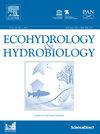Ecological water level regulation based on aquatic plant restoration in large reservoirs: A case study of Wangying Reservoir
IF 2.7
4区 环境科学与生态学
Q2 ECOLOGY
引用次数: 0
Abstract
The regulation of water levels based on water level requirements at different life-cycle stages of aquatic plants is a crucial measure for the restoration of aquatic plants. Based on the current situation of aquatic plants in the reservoir and the requirements for the water level of aquatic plants in different life cycle stages, the present study proposes the best ecological water level under different plant coverage restoration targets for the Wangying Reservoir. There were 184 species of aquatic plants in the Wangying Reservoir belonging to 142 genera in 61 families and 32 orders, with an average biomass of 2.35 kg/m2 and average density of 227 plants/m2. The total coverage of aquatic vegetation was 26 %, which included 15 % hygrophytes and emergent plants and 11 % submerged plants. The hygrophytes, emergent, and submerged plants have experienced discrepant life history stages and water level requirement even for the same life history stage. The fluctuations in the water level required for hygrophytes and emergent plants (2 m) were relatively more stable across different life cycle stages than for submerged plants (5 m). These results offer valuable guidance for the recovery of aquatic plants and reservoir management for the lentic water bodies.
基于大型水库水生植物恢复的生态水位调节:王英水库案例研究
根据水生植物不同生命周期阶段的水位需求进行水位调节是水生植物恢复的一项重要措施。根据库区水生植物现状及不同生命周期阶段对水生植物的水位要求,提出了王营水库不同植被覆盖恢复目标下的最佳生态水位。王营水库共有水生植物184种,隶属于32目61科142属,平均生物量2.35 kg/m2,平均密度227株/m2。水生植被总覆盖度为26%,其中湿生植物和水生植物占15%,沉水植物占11%。湿生植物、水生植物和淹没植物即使在同一生活史阶段也经历了不同的生活史阶段和对水位的要求。在不同的生命周期阶段,湿生植物和应急植物(2 m)所需的水位波动相对于淹没植物(5 m)更为稳定。这些结果对水生植物的恢复和生态水体的水库管理具有重要的指导意义。
本文章由计算机程序翻译,如有差异,请以英文原文为准。
求助全文
约1分钟内获得全文
求助全文
来源期刊

Ecohydrology & Hydrobiology
Agricultural and Biological Sciences-Aquatic Science
CiteScore
5.40
自引率
3.80%
发文量
51
期刊介绍:
Ecohydrology & Hydrobiology is an international journal that aims to advance ecohydrology as the study of the interplay between ecological and hydrological processes from molecular to river basin scales, and to promote its implementation as an integrative management tool to harmonize societal needs with biosphere potential.
 求助内容:
求助内容: 应助结果提醒方式:
应助结果提醒方式:


